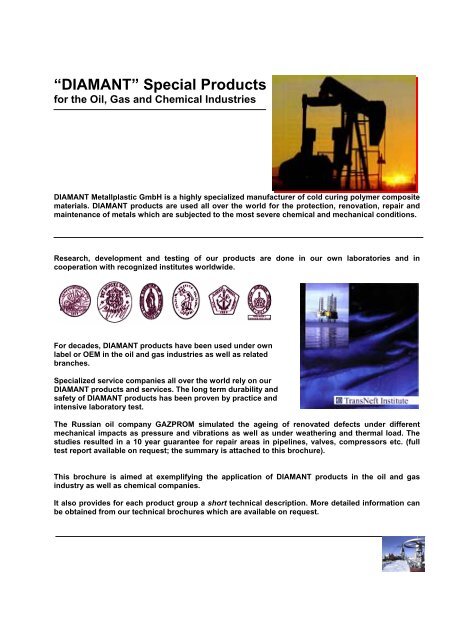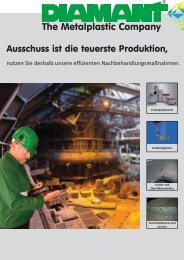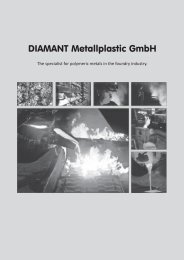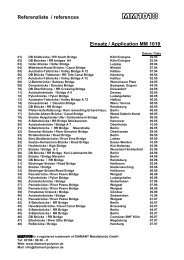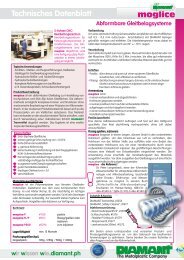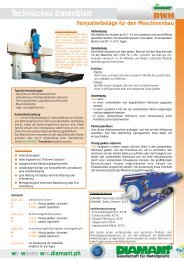“DIAMANT” Special Products - DIAMANT Metallplastic GmbH
“DIAMANT” Special Products - DIAMANT Metallplastic GmbH
“DIAMANT” Special Products - DIAMANT Metallplastic GmbH
You also want an ePaper? Increase the reach of your titles
YUMPU automatically turns print PDFs into web optimized ePapers that Google loves.
<strong>“<strong>DIAMANT</strong>”</strong> <strong>Special</strong> <strong>Products</strong><br />
for the Oil, Gas and Chemical Industries<br />
<strong>DIAMANT</strong> <strong>Metallplastic</strong> <strong>GmbH</strong> is a highly specialized manufacturer of cold curing polymer composite<br />
materials. <strong>DIAMANT</strong> products are used all over the world for the protection, renovation, repair and<br />
maintenance of metals which are subjected to the most severe chemical and mechanical conditions.<br />
Research, development and testing of our products are done in our own laboratories and in<br />
cooperation with recognized institutes worldwide.<br />
For decades, <strong>DIAMANT</strong> products have been used under own<br />
label or OEM in the oil and gas industries as well as related<br />
branches.<br />
<strong>Special</strong>ized service companies all over the world rely on our<br />
<strong>DIAMANT</strong> products and services. The long term durability and<br />
safety of <strong>DIAMANT</strong> products has been proven by practice and<br />
intensive laboratory test.<br />
The Russian oil company GAZPROM simulated the ageing of renovated defects under different<br />
mechanical impacts as pressure and vibrations as well as under weathering and thermal load. The<br />
studies resulted in a 10 year guarantee for repair areas in pipelines, valves, compressors etc. (full<br />
test report available on request; the summary is attached to this brochure).<br />
This brochure is aimed at exemplifying the application of <strong>DIAMANT</strong> products in the oil and gas<br />
industry as well as chemical companies.<br />
It also provides for each product group a short technical description. More detailed information can<br />
be obtained from our technical brochures which are available on request.
1. Sealing of corroded welding seams<br />
Leakages of welding seams of an empty oil storage tank have been repaired with<br />
UltraMetal Steel.<br />
UltraMetal Steel was applied on the exterior wall after thorough cleaning and roughening of the surface.<br />
Extreme protection is achieved by the following procedure with Dichtol and UltraMetal Steel:<br />
The cleaned and sand blasted welding seams are<br />
first impregnated with Dichtol which penetrates in the porosities (without pressure or vacuum) thus<br />
sealing them inside; after curing of Dichtol<br />
the remaining spot is then UltraMetal Steel applied.<br />
Example 1:<br />
The requirements were:<br />
longterm corrosion protection, resistance to gasoline, resistance to temperature cycles between –30 and<br />
60°C.<br />
The pressure resistance to 10 bar was checked by an independent test institute.<br />
Example 2:<br />
-2-
2. Repair of pitching in a corroded storage tank with UltraMetal Steel<br />
The holes in the tank were closed with paste-like UltraMetal Steel P and glass fibre reinforcement.<br />
The surface was subsequently covered with a top coat of liquid UltraMetal Steel FL.<br />
3. Repair of a pipeline with UltraMetal ST (Superthixo)<br />
A gas pipeline with a wall thickness of 16,5 mm and diameter of 1320 mm showed corroded areas at the<br />
underside. The depth of the defects were 4 to 10 mm. The repair was carried out by the service<br />
company Spezneftegas (Russia) with UltraMetal ST (“Superthixo”) which provides a very high sag<br />
resistance. Curing was accelerated by a tent covering the spot and heating by a mobile heater to about<br />
50°C.<br />
4. Pump station – repair on oily surfaces with UltraMetal Rapid and Steel<br />
The renovations were carried out on oily surfaces with the special grade UltraMetal Rapid which is the<br />
ideal material for emergency repairs.<br />
UltraMetal Rapid has been approved by Lloyds.<br />
-3-
5. Repair and long term protection of a storage tank with<br />
UltraMetal Steel, FlexCoat and ProChem 1931<br />
After repairing of the corroded areas with UltraMetal Steel, the outside of the tank was coated with<br />
FlexCoat. FlexCoat was specificly developed for large tanks which require flexible coatings due to the<br />
cyclical mechanical and thermal loads they are subjected to.<br />
For the coating of the inside of storage tanks – in particular the heavily corroded bottom of crude oil<br />
tanks – <strong>DIAMANT</strong> developed ProChem 1931. It offers the broadest resistance against a variety of<br />
aggressive chemicals. ProChem 1931 can be sprayed. Applications see below.<br />
6. Protection of large areas against chemical attacks with ProChem 1931<br />
Extreme protection of large areas is carried out with ProChem 1931 which offers the unique capability to<br />
protect against a very broad range of chemicals; i.e. highly concentrated acids, lyes and aggressive<br />
organic compounds.<br />
ProChem can be sprayed with a 2-component spray equipment at about 50°C and 300 bar. The photos<br />
below show a tanker for the transport of concentrated sulphuric acid and the coating of an exhaust<br />
system which is operated at 155°C.<br />
-4-
7. <strong>DIAMANT</strong> pressure tests of<br />
UltraMetal 1250 on oily surfaces<br />
Hole sizes between 6mm and 26mm were filled in a special process. Pressurizing until burst was<br />
videotaped enabling <strong>DIAMANT</strong> researchers to analyse and optimize the safety of the materials. The burst<br />
pressure ranged between 150 and 250 bar.<br />
Further systematic studies have been conducted investigating the parameters which have an impact on the<br />
burst pressure. Based on these tests, <strong>DIAMANT</strong> can provide a great deal of Know How and technical<br />
support to its customers.<br />
8. Extreme repair with <strong>DIAMANT</strong> products at Gazprom<br />
The Russian oil- and gas company GAZPROM tested the reliability of extreme repairs as shown below: A<br />
hole in a corroded test specimen was widened to a slot. A steel reinforcement was introduced inside and<br />
fixed with UltraMetal Steel. The tube was then pressurized and simultaneously subjected to mechanical<br />
impact.<br />
Long term tests showed crack forming only after a few years at a pressure above 100 bar (see also attached<br />
summary of the test report).<br />
-5-
9. Pump and valve repair<br />
A broad variety of pumps and valves have been repaired with <strong>DIAMANT</strong> materials.<br />
9.1. Repair of a crack in a valve with UltraMetal Iron<br />
The pictures show the preparation of the repair area by widening the crack V-shaped, drilling holes at the<br />
end (to avoid propagating of the crack) and sand roughening of the surrounding surface. UM Iron was<br />
then pressed into the gap and onto the surface.<br />
9.2 Precise adjustment of a shaft with PlasticMetal Steel<br />
MM 110,<br />
<strong>DIAMANT</strong> PlasticMetal products are composed of metal powder and hardener liquid which can be<br />
mixed in a free mixing ratio to a viscosity fitting exactly the individual requirement. Due to the fast curing<br />
within one hour, the precision adjustment of the loose shaft could be done within 1,5 h altogether.<br />
9.3. Repair of a heavily worn housing with PlasticMetal Ceram or UltraMetal Ceram<br />
Extremely worn casings can be repaired with both, PlasticMetal Ceram or UltraMetal Ceram.<br />
Repaired areas often show a longer service life than the original parts due to the firm embedding of<br />
special ceramic fillers.<br />
PlasticMetal products have a much faster curing in addition to the free mixing ratio whereas<br />
UltraMetal Ceram is more resistant if the repair-area is subjected to high mechanical impact, vibrations<br />
and cyclical loads. UltraMetal is also preferred if the repair spot is larger than 100 cm 2 .<br />
The photos show the repair of an extremely worn housing with PlasticMetal Ceram and a steel mesh<br />
reinforcement which is additionally fixed with screws.<br />
-6-
The following pages will give more technical information on the products<br />
(further information is available on request)<br />
Page 08 to 14: Summary of the Gazprom test report<br />
Page 15: Technical summary UltraMetal Steel, Cast Iron and Ceram<br />
Page 16: Technical summary UltraMetal Rapid<br />
Page 17: Technical summary UltraMetal ST Superthixo<br />
Page 18: Technical summary PlasticMetal<br />
Page 19: Technical summary Dichtol<br />
Page 20: Technical summary ProChem<br />
Page 21: Technical summary FlexCoat<br />
<strong>“<strong>DIAMANT</strong>”</strong> <strong>Products</strong> for the<br />
Oil & Gas Industries<br />
-7-
Ergebnisauszug aus dem 211-seitigen Prüfbericht 12/98<br />
Extract from Test results of 211 pages Test report 12/98<br />
GAZPROM – Moskau<br />
Thema: Garantieuntersuchungen – 10 Jahre Lebensdauer der Reparaturen<br />
unter Witterungsbedingungen und zyklischen Kraftbelastungen<br />
Theme: Guaranty tests - 10 years repair service life under weathering conditions and cyclical<br />
loads<br />
Prüfmaterial: „<strong>DIAMANT</strong>“ MultiMetall Stahl<br />
Tested Material: "<strong>DIAMANT</strong>" MultiMetal Steel<br />
Defect: round hole Ø 2 mm<br />
Fehlstelle: rundes Loch Ø 2 mm<br />
Jahre Prüfbericht Protokoll Rissbildung an Haftungsfläche teilweise Ablösung<br />
years Test Report Protocol Crack forming at adhesion<br />
surface<br />
Partial rupture<br />
Nr. / No. bei atm./ at bar bei atm. / at bar<br />
3,5 N 35 > 270 > 330<br />
7,0 N 47 > 268 > 315<br />
10,0 N 77 > 274 > 320<br />
Defect: long crack 25 x 2 mm<br />
Fehlstelle: länglicher Riss 25 x 2 mm<br />
Jahre Prüfbericht Protokoll Rissbildung an Haftungsfläche teilweise Ablösung<br />
years Test Report Protocol Crack forming at adhesion<br />
surface<br />
Partial rupture<br />
Nr. / No. bei atm./ at bar bei atm. / at bar<br />
3,5 N 56 > 129 > 175<br />
7,0 N 61 > 100 > 175<br />
10,0 N 62 > 100 > 162<br />
Nach diesen Ergebnissen erfolgte die Freigabe durch ein Leitpapier an alle Reparatur- und<br />
Instandhaltungsstationen die unter Verwaltung der GAZPROM stehen.<br />
Acc. to these results, GAZPROM acknowledged the repair for all Repair- and Maintenance-Stations<br />
under their control.<br />
-8-
Defekt „rundes Loch“<br />
Defect "round hole"<br />
Fig. 2.24 Rohrmuster für Vibrationsprüfung Fig. 2.29 Experimentielle Anlage für Hermetische<br />
Fig. 2.24 pipe specimen for vibration test Fig. 2.29 Experimental unit for hermetical control<br />
Fig. 2.3. Typisches Muster mit<br />
Defekt „rundes Loch“.<br />
Lebensdauerprobe 3,5 Jahre<br />
330 atm. „Erschöpfungsdruck“<br />
Fig. 2.3. typical specimen with<br />
defect "round hole".<br />
Service life test 3.5 years<br />
330 bar "fatigue pressure"<br />
Defekt "länglicher Riss"<br />
defect "long crack"<br />
Fig. 2.13. Typisches Muster mit<br />
Defekt „rundes Loch“.<br />
Lebensdauerprobe 7 Jahre<br />
315 atm. „Erschöpfungsdruck“.<br />
Fig. 2.13. typical specimen with<br />
defect "round hole".<br />
Service life test 7 years<br />
315 bar "fatigue pressure"<br />
-9-<br />
Fig. 2.16. Typisches Muster mit<br />
Defekt „länglicher Riß“<br />
Lebensdauerprobe 3,5 Jahre<br />
175 atm. „Erschöpfungsdruck“.<br />
Fig. 2.16. typical specimen with<br />
defect "long crack"<br />
Service life test 3.5 years<br />
175 bar "fatigue pressure"
Stutzen<br />
Inlet<br />
Defekt<br />
länglicher Riß<br />
defect long crack<br />
Defekt<br />
rundes Loch<br />
defect round hole<br />
Defekt Kaverne<br />
defect caverne<br />
Fig. 2.20. Rohrmuster mit großem Durchmesser (Typ B) (alle Defekte auf dem Muster dargestellt)<br />
Fig. 2.20. pipe specimen with large diameter (Type B) (all defects marked on specimen)<br />
Prüfmuster mit großem Durchmesser. Defekt „länglicher Riss“ vor und nach der Reparatur.<br />
Specimen with large diameter defect "long crack" before and after repair<br />
Prüfmuster mit großem Durchmesser. Defekt „länglicher Riss“ nach der Reparatur.<br />
Specimen with large diameter defect "long crack" after repair<br />
-10-
Prüfmuster mit großem Durchmesser. Defekt „rundes Loch“ vor und nach der Reparatur.<br />
Specimen with large diameter. Defect "round hole" before and after repair.<br />
Prüfmuster mit großem Durchmesser. Defekt „Riefen-Risse“ vor und nach der Reparatur.<br />
Specimen with large diameter. Defect "score-cracks" before and after repair.<br />
-11-
Preparation principle of the linear defect<br />
and the application of the support plate<br />
Das Schema des Vorbereitens des linearen<br />
Fehlers und das Anbringen der Unterlegplatte<br />
(A) a)<br />
(B) b)<br />
(C) c)<br />
(D) d)<br />
Repair principle of the through crack and the<br />
application of the support plate<br />
Das Schema der Reparatur des durchgehenden<br />
Fehlers mit der Verwendung der verstärkenden<br />
Metalllasche<br />
Abbildung 4<br />
1 = Wand des Behälters<br />
2 = Auftragen<br />
3 = verstärkende Metalllasche<br />
4 = zu reparierende Fehler<br />
1 = container wall<br />
2 = application<br />
3 = reinforcement<br />
4 = defect to be repaired<br />
a) 1 = das Zurichten des linearen Fehlers a) 1 = preparation of the linear defect<br />
2 = Vorbereitung der Unterlegplatte mit Drähten 2 = preparation of reinforcement plate with wires<br />
b) Einführen der Unterlegplatte am Fehler b) insertion of plate into defective area<br />
c) Anbringen der Unterlegplatte am Fehler c) fixing the plate inside the defective area<br />
d) der für die Reparatur vorbereitete Fehler d) defect prepared for repair<br />
1 = das zu reparierende Teil<br />
2 = das Auftragen<br />
Abbildung 5<br />
Repair principle of the through crack without reinforcement<br />
Das Schema der Reparatur des durchgehenden Fehlers ohne Versatzteil<br />
Abbildung 3<br />
1 = part to be repaired<br />
2 = application<br />
-12-
Principle of measuring the maximum defect size and area<br />
Das Schema der Messungen der maximalen Größen des Fehlers bei der Bestimmung seiner Fläche<br />
Abbildung 1<br />
Achse des<br />
Rohres<br />
pipe axis<br />
L = Länge des Fehlers L = defect length<br />
B = Breite des Fehlers B = defect width<br />
1 = Fehler 1 = defect<br />
2 = Rohr 2 = pipe<br />
Principle of marking<br />
Das Schema der Markierung und des Körnens im Bereich des reparierenden Fehlers<br />
1 = das zu reparierende Teil<br />
2 = der zu reparierende Fehler<br />
3 = die Linie, die äquidistant dem Umriß<br />
des Fehlers ist<br />
4 = Bereich des Körnens<br />
1 = part to be repaired<br />
2 = defect to be repaired<br />
3 = line marking defect<br />
4 = area of punching<br />
Principle of overhead repair<br />
Das Schema der Reparatur über den Kopf<br />
1 = das zu reparierende Teil<br />
2 = die reparierende Stelle<br />
3 = der Begrenzungsring<br />
4 = die Glasbandverstärkung<br />
5 = die provisorische Bandage<br />
1 = part to be repaired<br />
2 = repaired area<br />
3 = limiting area<br />
4 = glass fibre reinforcement<br />
5 = provisional bandage<br />
-13-
Principle of repair of a through defect using reinforcements<br />
Das Schema des Zurichtens des durchgehenden Fehlers unter der Verwendung des Versatzteiles und der<br />
verstärkenden Metalllasche<br />
steel sheet<br />
Lasche aus<br />
einem Stahlblech<br />
Umriß des Flickens<br />
repair area<br />
Schicht des Verbundst.<br />
material coating<br />
Versatzteil<br />
reinforcement plate<br />
Umriß des Fehlers<br />
container wall Putty steel sheet<br />
Wand<br />
des Beh.<br />
Verkitten Lasche aus<br />
einem Blech<br />
defect to be repaired der zu reparierende Fehler<br />
1 = der zu reparierende Abschnitt mit einem durchgehenden<br />
Fehler<br />
2 = das Versatzteil<br />
3 = Armierungsband<br />
4 = Auftragen des Materials<br />
1 = repair area with through crack<br />
2 = reinforcement plate<br />
3 = reinforcement tape<br />
4 = application of material<br />
-7-<br />
Schicht des Verbundstoffes material coating<br />
Rohr pipe<br />
repair area<br />
Flicken Umriß des Feldes<br />
-14-
®<br />
ultra<br />
metal<br />
Cast Iron, Steel and Ceram<br />
The UltraMetal series consists of cold curing 2 component polymer systems with selected fillers.<br />
UltraMetal has an excellent adhesion and almost no shrinkage on curing.<br />
As a result there is no tension in the repaired area and it is the ideal material for machines and equipment<br />
which are subjected to mechanical stress or vibrations and the like. As the processing time is at least 40 min<br />
UltraMetal is also the preferred material for large areas.<br />
UltraMetal Iron and Steel are general purpose materials for high quality repairs of iron or steel respectively.<br />
UltraMetal Ceram provides a long term wear resistance due to firmly embedded ceramic fillers.<br />
Technical Data<br />
Cast Iron / Steel<br />
P<br />
Cast Iron / Steel<br />
FL<br />
Ceram<br />
Ceram<br />
P FL<br />
Consistency Paste-like liquid Paste-like liquid<br />
Mixing ratio Resin/Hardener Weight 10:1 10:1 3,2:1 4,6:1<br />
Specific weight g / cm 3<br />
2,3 2,1 2,5 2,05<br />
Pot life 20°C /min. 60 60 60 60<br />
Curing time (full load) 20°C / h 24 24 24 24<br />
Compressive strength N/mm² 160 156 180 176<br />
Bending strength N/mm² 89 87 88 89<br />
Tensile strength N/mm² 76 77 74 75<br />
Hardness Shore D after 48 h 89 87 92 89<br />
Temperature resistance °C - 40 / 160 - 40 / 160 - 40 / 160 - 40 / 160<br />
Colour Grey Grey White white<br />
Shelf life Month 24 24 24 24<br />
-15-
®<br />
ultra<br />
metal<br />
Rapid<br />
UltraMetal Rapid is a cold curing 2-component polymer metal which combines the advantages of the<br />
Ultrametal products with a very short cure time. It is filled with mineral combinations. Main fields of<br />
application are emergency repairs requiring a fast cure. For convenience the mixing ratio of UltraMetal<br />
Rapid is 1:1 by weight or volume. A twin injector is available.<br />
Due to special additives UltraMetal Rapid can be applied directly onto oily, greasy or gasoline-soiled<br />
surfaces. Leakages under moderate pressure can be sealed on ground of the rapid curing time.<br />
Technical Data<br />
Consistency paste<br />
Mixing ratio Resin/Hardener Weight 1:1<br />
Mixing ratio Resin/Hardener Volume 1:1<br />
Specific weight g / cm 3<br />
1,5<br />
Pot life 20°C /min. 3<br />
Curing time 20°C / h 0,5 (light<br />
load)<br />
1,0 (full load)<br />
Compressive strength N/mm² 155<br />
Bending strength N/mm² 79<br />
Tensile strength N/mm² 60<br />
Hardness Shore D after 48 h 86<br />
Temperature resistance °C -30/+100<br />
Colour Grey<br />
Shelf life Month ~ 12<br />
Pressure Test by Lloyds on dry, wet and oily surfaces:<br />
Adhesion<br />
Surface<br />
Thickness<br />
d<br />
(mm)<br />
Curing time<br />
(h)<br />
Test Material: UltraMetal<br />
Base material: R ST 37 – 2<br />
Adhesion surface: grit blasted,<br />
dry / wet / oily<br />
Temperature: RT & 60°C<br />
Curing temperature max. pressure<br />
P (bar)<br />
dry 10 6 RT > 250<br />
wet 10 6 RT > 150<br />
oily 10 6 RT > 100<br />
oily 10 6 60°C > 150<br />
oily 10 24 60°C > 120<br />
Quality Engineering<br />
Quality planing, construction supervision, testing,<br />
QA/QC manuals, commissioning<br />
Blohm+ Voss AG<br />
Abteilung TQ 14<br />
Hermann-Blohm-Straße 3<br />
2000 Hamburg 11<br />
-16-
®<br />
ultra<br />
metal<br />
Superthixo<br />
UltraMetal Superthixo is a special formulation with drip-proof viscosity for thick vertical or overhead<br />
coatings.<br />
UltraMetal Superthixo<br />
- is based on the standard UltraMetal Steel formulation with a very high content of metallic-ceramic filler<br />
combinations<br />
- was formulated for deep, large defects to be repaired in one application process<br />
- is the ideal formulation to repair & maintain defects caused by erosion, corrosion, cavitation, abrasion and<br />
to build-up or replace worn, defective or broken edges, surfaces, vertical rims in all kinds of industries.<br />
Technical Data<br />
Consistency putty<br />
Mixing ratio Resin/Hardener Weight 10:1<br />
Specific weight g / cm 3<br />
2,0<br />
Pot life 20°C /min. 50<br />
Curing time 20°C / h 24<br />
Fully cured / chemically fully resistant 20°C / days 7<br />
Compressive strength N/mm² 165<br />
Bending strength N/mm² 85<br />
Tensile strength N/mm² 74<br />
Hardness Shore D after 48 h >80<br />
Temperature resistance °C -20/+160<br />
Color Grey<br />
Shelf life Month ~ 12<br />
-17-
Cast Iron and Ceram<br />
The PlasticMetal series consists of a liquid hardener and a powder containing metals, fillers and additives.<br />
Both components can be mixed in a free mixing ratio.<br />
As a result almost any viscosity from liquid to paste can be mixed with one package.<br />
Further advantages are the high chemical and thermal resistance. Due to the short curing time PlasticMetal<br />
is mostly used for smaller areas. The repair spots can be machined after half an hour.<br />
PlasticMetal Ceram is a special grade for highly wear resistant repairs.<br />
<strong>DIAMANT</strong> offers a great variety of further metal powders and special hardeners to meet individual requirements<br />
(see technical brochure).<br />
Technical Data 1)<br />
Consistency liquid to paste<br />
Mixing ratio Powder/Hardener liquid Weight free! (min. 2 parts metal powder)<br />
Specific weight g / cm 3<br />
depending on the mixing ratio 1.2 - 5<br />
Pot life 20°C /min. 10 - 20<br />
Curing time (full load) 20°C / h 2<br />
Compressive strength N/mm² ca. 160<br />
Bending strength N/mm² 95<br />
Tensile strength N/mm² 86<br />
Hardness Shore D after 48 h 85 - 92<br />
Temperature resistance °C with hardener liquid WF up to +250°C continuous load<br />
Colour metallic or white (Ceram)<br />
Shelf life Month 12<br />
1) The values represent average values.<br />
®<br />
-18-
Dichtol is a one component ready-for-use liquid with the unique property to seal microporosities and hairline<br />
cracks without pressure or vacuum.<br />
Dichtol is simply applied by brushing, spraying, dipping or filling the item to be impregnated. As Dichtol<br />
seals inside, the surface film can be removed without loss of tightness. Consequently, Dichtol is the ideal<br />
material for the impregnation/sealing of parts which are subjected to severe chemical and mechanical<br />
conditions on the surface.<br />
Dichtol Standard seals porosities up to 0.1 mm;<br />
Dichtol Macro up to 0,5 mm.<br />
The WF-grade has an improved thermal resistance.<br />
Dichtol HTR is resistant up to 500°C continuous load. HTR is the only grade which requires annealing at<br />
250°C for a few hours after application.<br />
Dichtol is being used in the industry for decades. It has been approved by a lot of classification societies as<br />
well as public and private research and test institutes.<br />
Technical Data<br />
Properties General purpose Higher thermal<br />
resistance<br />
Standard WF WF Macro HTR<br />
Higher thermal<br />
resistance combined<br />
with larger pores<br />
-19-<br />
Extreme thermal<br />
resistance<br />
Maximum size of the porosities 0,1 mm 0,1 mm 0,5 mm 0,1<br />
Maximum continuous thermal load - 170 to 120°C - 170 to 200°C - 170 to 200°C - 170 to 500°C<br />
Application by<br />
Dipping<br />
Brushing<br />
Filling<br />
Spray can<br />
Dipping time [min]<br />
to 5 mm wall thickness<br />
5-10 mm wall thickness<br />
10-15mm wall thickness<br />
> 15 mm<br />
Y<br />
Y<br />
Y<br />
Y<br />
4<br />
8<br />
13<br />
30<br />
Surface dry after [min] 1 1 5 -<br />
Cure time<br />
to 5 mm wall thickness<br />
5-10 mm wall thickness<br />
10-15mm wall thickness<br />
> 15 mm<br />
Viscosity at 20°C<br />
DIN 53211 (4 mm nozzle)<br />
Light / full load<br />
4 / 24<br />
8 / 24<br />
13 / 48<br />
24 / 48<br />
Y<br />
Y<br />
Y<br />
Y<br />
4<br />
8<br />
13<br />
30<br />
Light / full load<br />
4 / 24<br />
8 / 24<br />
13 / 48<br />
24 / 48<br />
Y<br />
Y<br />
Y<br />
N<br />
6<br />
10<br />
15<br />
40<br />
Light / full load<br />
6 / 24<br />
10 / 24<br />
15 / 48<br />
24 / 48<br />
Y<br />
Y<br />
Y<br />
N<br />
10<br />
15<br />
20<br />
30<br />
1 h after dipping<br />
anneal at 250°C for 3<br />
h<br />
10-12 14-16 20-22 12-14
ProChem 1931 is a liquid cold curing 2-component<br />
formulation with an extreme chemical resistance.<br />
ProChem 1931 is unique in its ability to protect against<br />
most inorganic acids as well as aggressive organic<br />
chemicals and solvents.<br />
As a result, ProChem 1931 is especially well suited if there is the requirement to protect against mixtures of<br />
different aggressive chemicals.<br />
Technical Data<br />
Consistency liquid<br />
Mixing ratio<br />
Volume 2 : 1<br />
Resin/Hardener<br />
Weight 2,1 : 1<br />
Specific weight resin with hardener g/cm 3 1,3<br />
Pot life 20°C /min. 40<br />
Curing time 20°C / h 24<br />
Fully cured / chemically fully resistant 20°C / days 7<br />
Compressive strength N/mm² 120<br />
Tensile strength N/mm² 48<br />
Hardness Shore D after 48 h >80<br />
Temperature resistance °C -20/+170<br />
Colour Grey<br />
Quantity for 1 m² with a thickness of 0,35 mm g ~ 500<br />
Minimum processing temperature °C + 15<br />
Shelf life Month ~ 12<br />
Chemical resistance<br />
1931<br />
Organic chemicals<br />
Acetone 1-2 swelling<br />
Methanol 1-2<br />
Methylene chloride 2 swelling<br />
Phenol (aqueous) 1-2<br />
Acids<br />
Acetic acid (10 %) 1-2<br />
Acetic acid (50 %) 3<br />
Lactic acid 1<br />
Phosphoric acid (85 %) 1<br />
Nitric acid (10 %) 1-2<br />
Nitric acid (60 %) 3<br />
Hydrochloric acid (37 %) 2<br />
Sulphuric acid (96 %) 1-2 surface<br />
matt<br />
Lyes<br />
Ammonium hydroxide (20 %) 1<br />
Potassium hydroxide (20 %) 1<br />
Sodium Hydroxide (20 %) 1<br />
1= Long term resistance when immersed 3= Resistant when cleaned immediately<br />
2= Resistant when immersed for short times 4= Not resistant<br />
-20-
FlexCoat is a liquid, permanently elastic 2-component epoxy-formulation for the exterior corrosion protection<br />
of tanks, silos, tubes, pipelines, valves and the like.<br />
Due to its flexibility FlexCoat is the proper material for any equipment which is subjected to cyclical thermal<br />
or mechanical loads.<br />
FlexCoat is weatherproof. It combines high chemical and wear resistance with good levelling properties.<br />
FlexCoat can be brushed, rolled or sprayed.<br />
Technical Data<br />
Consistency liquid<br />
Mixing ratio<br />
Volume 2 : 1<br />
Resin/Hardener<br />
Weight 2 : 1<br />
Specific weight resin with hardener g/cm 3 1,35<br />
Coverage of 1 kg with a thickness of 1 mm sqm 0,75<br />
Pot life 20°C /min. 40<br />
Curing time 20°C / h 24<br />
Fully cured / chemically fully resistant 20°C / days 7<br />
Hardness Shore D after 14 d 70<br />
Temperature resistance °C -20/+120<br />
Colour Grey or red<br />
Shelf life Month ~ 12<br />
-21-<br />
1
New Formulation by Diamant: “UltraMetal 1250”<br />
High Pressure Tests 20/04/2005<br />
Material tested:<br />
“Diamant” UltraMetal 1250, semi-fluid viscosity, applied by special procedure.<br />
UltraMetal 1250 is now going to be tested by various Registers and Laboratories<br />
worldwide for further evidence of its unsurpassed qualities.<br />
Test pressure tube made from steel, 7mm thickness,<br />
Hole sizes diameters between 4mm to 26mm,<br />
Oil pressure manually generated, checked by a manometer.<br />
Tests executed “Diamant” Laboratory, Moenchengladbach, Germany,<br />
Aug. 15 – 23, 2002, by Janos Madarasi,<br />
Tests video-taped, available on CDrom<br />
Hole Diameter pmax Cure time at Remarks<br />
mm bar / psi hours °C / °F<br />
4 220 / 3,190 2 60 / 140 test stopped by small adhesion break<br />
6 200 / 2,900 2 60 / 140 test stopped by small adhesion break<br />
8 220 / 3,190 12 20 / 68 test stopped by small adhesion break<br />
10 250 / 3,625 ! 12 18 / 64 test stopped by small adhesion break<br />
12 160 / 2,320 ! 1 21 / 70 cure time too short, misprepared<br />
14 225 / 3,263 ! 2 60 / 140 test stopped by small adhesion break<br />
16 205 / 2,973 2 60 / 140 test stopped by small adhesion break<br />
18 220 / 3,190 12 18 / 64 test stopped by small adhesion break<br />
20 190 / 2,755 2 60 / 140 test stopped by long adhesion break<br />
22 185 / 2,683 2 60 / 140 test stopped by small adhesion break<br />
prep. not sufficient<br />
24 175 / 2,538 12 19 / 66 test stopped by small adhesion break<br />
prep. not sufficient<br />
26 210 / 3,045 2 60 / 140 test stopped by small adhesion break<br />
Innovational defect repair of pipes, tubes, containers, …<br />
for any type of metal carrying any type of gas or liquid<br />
now available as per latest patented procedure.<br />
-22-
-23-<br />
®<br />
ultra<br />
metal<br />
Test pressure tube made from steel, 7mm<br />
thickness,<br />
Holes drilled with various<br />
diameters from 4mm to<br />
26mm,<br />
Oil pressure manually generated,<br />
checked by a manometer.<br />
Tests executed “Diamant” Laboratory,<br />
Moenchengladbach,<br />
Germany,<br />
Aug. 15 – 23, 2002, by<br />
Janos Madarasi,<br />
Tests video-taped, available on Cdrom!


